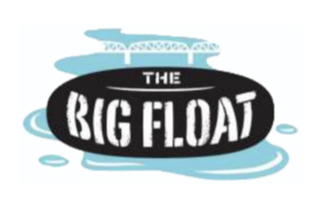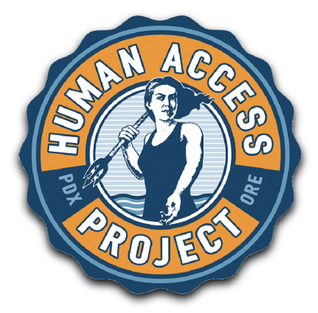The Oregon Museum of Science and Industry is a science and technology museum in Portland, Oregon, United States. It contains three auditoriums, including a large-screen theatre, planetarium, and exhibition halls with a variety of hands-on permanent exhibits focused on natural sciences, industry, and technology. Transient exhibits span a wider range of disciplines.

The Willamette Falls is a natural waterfall in the northwestern United States, located on the Willamette River between Oregon City and West Linn, Oregon. The largest waterfall in the Northwest U.S. by volume, it is the seventeenth widest in the world. Horseshoe in shape, it is 1,500 feet (455 m) wide and forty feet (12 m) high, with a flow rate of 30,850 cu ft/s (874 m3/s). Located 26 miles (42 km) upriver from the Willamette's mouth at Portland, Willamette Falls is a culturally significant site for many tribal communities in the region.

Governor Tom McCall Waterfront Park is a 36.59-acre (148,100 m2) park located in downtown Portland, Oregon, along the Willamette River. After the 1974 removal of Harbor Drive, a major milestone in the freeway removal movement, the park was opened to the public in 1978. The park covers 13 tax lots and is owned by the City of Portland. The park was renamed in 1984 to honor Tom McCall, the Oregon governor who pledged his support for the beautification of the west bank of the Willamette River—harkening back to the City Beautiful plans at the turn of the century which envisioned parks and greenways along the river. The park is bordered by RiverPlace to the south, the Steel Bridge to the north, Naito Parkway to the west, and Willamette River to the east. In October 2012, Waterfront Park was voted one of America's ten greatest public spaces by the American Planning Association.

Samuel Francis Adams is an American politician in Portland, Oregon. Adams was mayor of Portland from 2009 to 2012 and previously served on the Portland City Council and as chief of staff to former Mayor Vera Katz. Adams was the first openly gay mayor of a large U.S. city.

Edward Tevis Wheeler is an American politician who has served as the mayor of Portland, Oregon since 2017. He was Oregon State Treasurer from 2010 to 2016.

On Tuesday, May 17, 2016, an election was held in Portland, Oregon, to elect the mayor. Ted Wheeler was elected after garnering 54% of the primary vote. Incumbent mayor Charlie Hales did not seek a second term.

Poet's Beach is an urban beach along the Willamette River, near Portland, Oregon's Marquam Bridge, in the United States.

Audrey McCall Beach is an urban beach along the east bank of the Willamette River, near the Hawthorne Bridge in Portland, Oregon, United States.

The Big Float was an annual July celebration of the Willamette River in Portland, Oregon, United States. Established in 2011, as a benefit for the Human Access Project, attendees formed a giant people-powered flotilla and beach party to encourage Portlanders to reclaim the Willamette River for swimming and other aquatic recreation.

Human Access Project (HAP) is an organization based in Portland, Oregon, whose mission is "transforming Portland's relationship with the Willamette River". The organization's vision is a city in love with its river. HAP was founded by Willie Levenson, whose official title is the organization's Ringleader, is a tireless and effective advocate for swimming in the Willamette River he brings his love of water to his work as an activist for recreational access to the Willamette River in Portland.

The COVID-19 pandemic was confirmed to have reached Portland in the U.S. state of Oregon on February 28, 2020.

The Kevin J. Duckworth Memorial Dock is a dock on the Willamette River, along Portland, Oregon's Eastbank Esplanade.

Reo's Ribs is a barbecue and soul food restaurant in Portland, Oregon.
Mike Bennett is an American visual artist based in Portland, Oregon. He studied art education and has worked as a preschool teacher.
Rene Gonzalez is an American businessman, politician, and former lawyer. He has held a seat on the Portland, Oregon City Council since January 2023. He challenged incumbent commissioner Jo Ann Hardesty in the 2022 election, running on a platform that emphasized law and order and livability.

The Midtown Beer Garden is a food cart pod in Portland, Oregon, United States. The pod is the city's oldest, operating since the early 1980s. Following an update and renovation in 2023, the pod became known as Midtown Beer Garden. Notable tenants include Bing Mi, Stretch the Noodle, and Tokyo Sando.

In Portland, Oregon, Christmas trees have been installed at Pioneer Courthouse Square annually since the public space opened in 1984. The trees have been donated by Stimson Lumber Company since 2002, and are delivered the week of Veterans Day. With some exceptions, the trees are 75-foot-tall Douglas firs, decorated with thousands of multi-colored LED lights.

The Portland Stand Up Paddleboard Witches on the Willamette, more commonly known as "Witches on the Willamette", or simply the witch paddle, is an annual witch-themed standup paddleboarding event in Portland, Oregon. Ginny Kauffman organized the first event in 2017.

The Portland Winter Ice Rink is an ice rink, temporarily installed during winter months in Portland, Oregon, United States. Prosper Portland launched the project for the 2023–2024 season, and popular demand prompted the economic development organization to organize the rink again for the 2024–2025 season.

Weird Portland United is a nonprofit organization based in Portland, Oregon, United States. Brian Kidd, who is known as the Unipiper, founded the collective in 2018 in an effort to "Keep Portland Weird".


















